Imagine you are an anxious mum taking your child to hospital with suspected meningitis.
Before you can reach the door, you must pass a group of around 100 people, carrying posters and placards, including images of foetuses in wombs.
The woman, who lost a pregnancy just four days previously, breaks down in tears and finds it almost impossible to leave her car.
Or you are a junior doctor, working in an outpatient department which neighbours a sexual health clinic. You terminated a pregnancy some 10 years earlier when your marriage broke down – and now, just to get to work, you must walk past graphic posters calling you a murderer.
Or you are a consultant in sexual and reproductive health. You are trying to hold consultations with vulnerable young women – but the noise from the street is so bad that you have had to decamp to another part of the building, and you worry that some patients will have been put off attending.
These are just a few snapshots, based on real incidents, showing the effect of anti-abortion ‘vigils’, sometimes held outside abortion clinics, but also next to hospitals or other health facilities.
The BMA has campaigned for many years to support access to abortion, arguing that severely restricting abortion does not prevent abortions – it only prevents safe termination of pregnancy. It also supports decriminalisation of abortion, with limits subject to professional and regulatory sanctions, rather than criminal sanctions.
Campaigners, including the BMA, have been working for years to try to win buffer zones around abortion clinics, so patients and staff are no longer forced to walk the gauntlet of protesters when going to work or accessing services.
When the UK’s Supreme Court ruled the Northern Ireland Assembly could legislate to create buffer zones around abortion clinics, it felt like a watershed moment. It also felt like a riposte to the disturbing developments in the USA, where, following the overturning of Roe v Wade in June 2022, individual states have had the right to curtail or ban abortions. Surely, UK campaigners thought, this could never happen here.
However, despite the Northern Ireland ruling – and a subsequent vote in UK Parliament which made legal provision for buffer zones in England and Wales – there are still concerns women do not have equal access to safe abortion services.
And in parts of the UK – most notably in Scotland – there has been little progress on buffer zones, despite the avowed support of first minister Humza Yousaf and his predecessor Nicola Sturgeon.
Intimidating crowds
Audrey Brown is a leading campaigner for decriminalisation of abortion and a fierce advocate of buffer zones. With many years’ experience as a consultant in sexual and reproductive healthcare at NHS Greater Glasgow and Clyde, she has witnessed first-hand the effect campaigners have on women attending the city’s hospitals – and not only on those seeking abortion.
 BROWN: Gatherings are intimidating
BROWN: Gatherings are intimidating
‘Sometimes there are up to 100 people, standing in a big line, with placards and posters, across from the entrance to the gynaecology and maternity unit, and they pray together,’ she says.
‘Although it’s supposed to be a peaceful prayer vigil – they’re not shouting at people – when you get these big gatherings of 100 people praying in unison, it’s very intimidating to pass them, for patients and for staff.
‘And although the medical abortion unit is in the building, the maternity unit is there too, so people who have had a late miscarriage, or foetal abnormality, or a stillborn baby – they’re all having to go past them to enter the obstetric unit.’
The BMA is clear on this. We called for decriminalisation in 2017, and reaffirmed it in 2019Dr Patel
At the Sandyford, the community sexual health clinic where she worked before retiring in December, the modus operandi of the protesters is different, she says, with random ‘pop-up’ protests.
‘There’s a sort of “fire and brimstone” pastor and his pal who appear outside the clinic, literally 20 feet from the door. They have voice amplification and they roar out passages from the Bible and saying that abortion is murder, that the staff are sinners, and that patients are sinners. It’s incredibly noisy – to the extent it’s impossible to consult in the rooms at the front of the building when they are there.’
What is particularly alarming for patients and staff is that protesters wear body cameras, she adds. ‘At one point they put a bit of footage on social media of a member of NHS staff caught on film, saying this man was involved in abortion care – which was total nonsense as he was a driver taking samples to the lab, and nothing to do with the abortion service. But it is obviously anxiety-provoking for staff.
‘The man would have been identifiable from the footage and he was at the clinic every day, so that is potentially quite dangerous for him. I mean, we’re not at the US state of affairs quite yet, but someone could have hung around and attacked that man.’
Police intervention
It is intimidating for staff, but she also worries it might put people off accessing healthcare. ‘Sometimes you get counter-protests or members of the public remonstrating with them.
Sometimes you end up with a [fight] outside the clinic and then the police get called. If someone is coming along and is already feeling anxious and stigmatised and not sure about attending the clinic, and see all this happening, are they actually going to risk it to walk through? Which of course is what the anti-abortion campaigners are trying to achieve.’
She believes buffer zones would make a difference, but they would have to be adaptable depending on site. The proposed 150 metres would move the protesters significantly away from the entrance of the Sandyford, for example, but would do little to protect women attending the Glasgow Royal Infirmary or Queen Elizabeth Hospital; it would just move them a bit further down the road that women need to come along for access to services.
When you get these big gatherings of 100 people praying in unison, it’s very intimidatingDr Brown
Dr Brown, who was until recently chair of the Scottish Abortion Care Providers network, believes abortion should be decriminalised – for reasons that are ideological and practical.
‘I think it would make it modern-day healthcare,’ she says simply. ‘It would remove a lot of the barriers, such as the stigma, and the need for two [doctors’] signatures. I’m aware that sometimes it can be difficult to have a completely open consultation with someone, because if they have some doubts about whether abortion is something they really want to do, they’re not going to express that because they think you won’t sign their certificate.’
Calls for decriminalisation took on a new urgency last month when a woman was given a 28-month prison sentence for terminating a pregnancy after the legal limit. The mother-of-three was charged under the 1861 Offences Against the Person Act for ‘administering drugs or using instruments to procure abortion’, having lied to service providers about how far on her pregnancy was.
Archaic law
Latifa Patel, chair of the BMA representative body, strongly believes abortion should be decriminalised.
‘I can’t believe we’re having this conversation in 2023,’ she says. ‘The BMA is very clear on this. We called for decriminalisation in 2017, and reaffirmed it in 2019. Last year we made an exception at the annual representative meeting and had our colleagues from the American Medical Association talk about Roe versus Wade, because this is an issue that transcends boundaries – it’s not just what’s happening in the UK, it’s what is happening in the rest of the world too.
‘Abortion is a medical treatment, and currently we’re letting our patients down, letting society down, and letting vulnerable women down.’
While she welcomes legislation to introduce buffer zones, she wants to see more action. ‘There are still pockets of the UK where abortion is inaccessible, and that shouldn’t be the case. Imagine going to a scope clinic – being hounded going for a colonoscopy, being stopped going into the building, being terrified of going anywhere near it.
Then being told you had to have two medical signatures before being able to access that treatment. That’s what we’re talking about.
‘We’re absolutely clear abortion is a medical treatment and shouldn’t be treated as a criminal act. The bottom line is that government needs to do more.’
Picket lines
Lucy Grieve is co-founder of Back Off Scotland, a campaign group set up in 2020 to persuade the Scottish Government to introduce buffer zones, or protest-free areas, around clinics that provide abortion services.
She is also policy and engagement manager at British Pregnancy Advisory Service, which has campaigned for buffer zones across the UK, and which provides abortion services.
 MACKAY: Scotland may be last to install buffer zones
MACKAY: Scotland may be last to install buffer zones
She is disappointed that successive efforts to introduce buffer zones in Scotland – including a bill proposed by Green member of the Scottish Parliament Gillian Mackay – have not succeeded.
‘It’s very frustrating – in Scotland, we should have been leading the way on buffer zones, but it looks as though we’ll be the last place in the UK to have them.
‘Since we set up the campaign, we’ve heard from hundreds of people with really awful stories. There have been people who have had to terminate much-wanted pregnancies – they’ve already decorated the nursery, and then they have to end the pregnancy and they’re confronted by pictures of mutilated foetuses. Or people who have experienced sexual assault and are going for counselling or rape kits at their local sexual-health centre, and it’s been picketed.
Abortion is a medical treatment, and currently we’re letting our patients downDr Patel
‘The common thread is that people have told us they’ve felt harassed, they’ve felt intimidated, it’s made them feel worse, and it’s acted as a barrier to healthcare.’
Scotland’s current first minister has said he is in favour of decriminalising abortion, but given the slowness in introducing buffer zones, campaigners won’t be holding their breath.
‘I think we took a radical step in having the Abortion Act passed in the 1960s, but it’s not fit for modern-day Britain – it needs to be radically revised or outright scrapped, and something else put in its place,’ says Ms Grieve.
‘As far as we’re concerned, abortion should be a right – it’s giving a woman choice over what is happening with her body. It’s healthcare, and access needs to be protected.’
Northern Ireland
The Northern Ireland Assembly passed legislation for buffer zones in June 2022, but this was challenged by the country’s own attorney general. The UK Supreme Court ruled in December it was within the legislative competence of the Assembly to pass the law. The Department of Health said in May that it would publish details of buffer zones once they were operational. Abortion was effectively decriminalised in Northern Ireland in 2019, but in practice, there are still gaps in provision of abortion services.
England and Wales
The Public Order Act 2023 introduces safe-access zones around abortion clinics, where interference with an individual’s decision to access, provide or facilitate the provision of abortion services within 150 metres is an offence that carries an unlimited fine. Under the 1967 Abortion Act, terminations in England and Wales up to 24 weeks are legal under certain circumstances, but women – and doctors – can still face prosecution if, for example, it is suspected that pregnancy loss breaches the law.
Scotland
Proposed legislation to implement buffer zones was lodged in the Scottish Parliament by Green MSP Gillian Mackay in June. Scotland is governed by similar legislation to England and Wales but the penalties of ending your own pregnancy outside the confines of the act are less clear.

